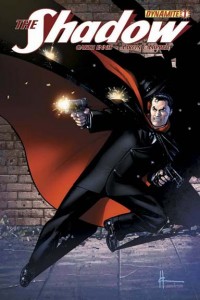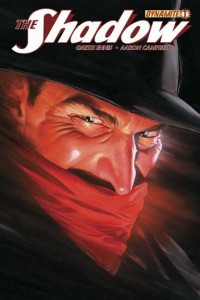 Garth Ennis’s The Shadow does many things effectively, including presenting an interesting “modern” characterization of the title character (considering, unlike Howard Chaykin’s 1980s reboot for DC Comics, Ennis writes this as a period piece), slowly introducing The Shadow’s “faithful companions” for people who aren’t necessarily already familiar with them, and, within 22 pages, setting the stage for a story that is international and possibly terrifying in scope.
Garth Ennis’s The Shadow does many things effectively, including presenting an interesting “modern” characterization of the title character (considering, unlike Howard Chaykin’s 1980s reboot for DC Comics, Ennis writes this as a period piece), slowly introducing The Shadow’s “faithful companions” for people who aren’t necessarily already familiar with them, and, within 22 pages, setting the stage for a story that is international and possibly terrifying in scope.
However, the thing it does most effectively is to instill a deep and visceral unholy rage toward the government and military of the nation of Japan, circa 1939, to the point where when I was finished with the book, I wished that Oppenheimer and company had built a third nuke. A shit nuke. That caused a mushroom cloud made of feces. Which is a feeling that I personally found to be pretty damned disturbing. But I’ll come back to that.
Let’s move to an admission: I am not all that familiar with The Shadow, at least when it comes to the character’s Street And Smith pulp origins. Sure, I’ve read Chaykin’s miniseries, and I have a couple of issues of the Andy Helfer series that followed it, and I saw the 1994 movie starring Alec Baldwin and that 80s movie actress who isn’t what’s-her-face from Weeds. So what I knew about the character was based on those sources: that he carries two guns, and that he has some kind of power to “cloud men’s minds,” which, in the sources I’ve read, amounts to: “Hey! I have the ability to cloud men’s minds (shoots criminal in face)!”
And frankly, I’m not sure that anyone really knows what The Shadow’s historical power set is, assuming anyone’s ever sat down and tried to quantify them. But here, Ellis makes a bunch of powers evident. The Shadow can apparently read minds, see people’s eventual fates, and prevent the recently dead from being, you know, dead. And yes; he can “cloud men’s minds,” in the sense that he can cause people to suffer mild hallucinations. And while on one hand, these abilities make one suspect that Ennis’s local mescaline dealer refers to his primo wares as “The Shadow,” it also elevates The Shadow above the simple “vigilante with two guns” image that many have of the character. Most of these powers are introduced in an opening sequence where The Shadow wipes out a crew of twelve armed goons without breaking a sweat, and they make the character formidable, which is going to be key given the stakes Ennis seems to have in mind for this story.
And the stakes are ambitious for a character most widely known shooting gangsters while cackling like a 12-year-old who found Dad’s skunkweed and copy of Animal House. This story is international in scope, involving The Shadow’s alter ego, Lamont Cranston, working with American Intelligence while pursuing his own ends when in costume. The biggest disappointment in the book is that sub rosa work that Cranston is performing, in the sense that I have no idea what the hell it is. We’re shown a long sequence of Cranston reporting to his proto-CIA handlers about the efforts to recover… something from the Far East before the Japanese. What thing? Beats the shit out of me. Might be a nuke, might be the ghost of James Bond. I’m sure it will be revealed in time, but I found the oblique talking around of the unknown MacGuffin to be a little distracting.
 The one thing that is not oblique here is the description of the Japanese military. In the first five pages, Ennis relates war crimes committed by the Japanese army during the 1930s that are so lurid, reprehensible and disgusting that they would make Jeffrey Dahmer shudder with empathy. We’re talking rampant rape, butchery and torture that is simply horrifying to contemplate, if true. The effect of this sequence is two-fold: first, it dehumanizes Japan and its leadership and military, to the point where you immediately start wanting The Shadow to do his worst to them (“Cloud those minds, Shadow! And I’m using ‘cloud’ in the ‘mist of vapor’ sense!”). And second, it makes you want to stomp the living shit out of any of-age Japanese male eligible for military service, up to and including The Donger from Sixteen Candles (“No more yanky my wanky! The Donger needs…” “Justice.” BLAM BLAM BLAM).
The one thing that is not oblique here is the description of the Japanese military. In the first five pages, Ennis relates war crimes committed by the Japanese army during the 1930s that are so lurid, reprehensible and disgusting that they would make Jeffrey Dahmer shudder with empathy. We’re talking rampant rape, butchery and torture that is simply horrifying to contemplate, if true. The effect of this sequence is two-fold: first, it dehumanizes Japan and its leadership and military, to the point where you immediately start wanting The Shadow to do his worst to them (“Cloud those minds, Shadow! And I’m using ‘cloud’ in the ‘mist of vapor’ sense!”). And second, it makes you want to stomp the living shit out of any of-age Japanese male eligible for military service, up to and including The Donger from Sixteen Candles (“No more yanky my wanky! The Donger needs…” “Justice.” BLAM BLAM BLAM).
Is the instilling of these kinds of emotions intentional? I submit that Ennis is too good a writer for it not to be. Is it fair? Well, for the purposes of a good story, almost nothing is unfair. Is it one-sided and jingoistic? Hell yes; replace these war crime descriptions with My Lai and Abu Ghraib by a good enough writer and you’ll want to go trolling for Ronald McDonald and Mickey Mouse. Is it disturbing? Yeah, it is… but by introducing an antagonistic force that is quickly shown to be willing to dehumanize its victims, it leads to tantalizing parallels to the protagonist, whose classification between “hireling” he will let live and “scum” who can be summarily executed amounts to the angle of a gun barrel. In the final analysis, it might lead to a layered and interesting story in the long run… but for now, just accept that it might make you feel just icky about yourself.
Aaron Campbell’s art in the book is just about pitch-perfect for a resurrected pulp hero. His style is generally realistic, with normal, human figures (This takes place in the 1930s, when the concept of a performance-enhancing drug included a Martini), simple lines, and gory violence to match the blood-soaked descriptions from old pulps. Colorist Carlos Lopez uses a limited palette, generally sticking with darker earth tones that are accented by the bright red of The Shadow’s cloak lining and, well, blood. If there’s a negative here, it’s in nitpicking storytelling errors; in one sequence, we see The Shadow holding both guns, then reloading with one hand, then holding both guns again. It detracts from the impact of a tense standoff to have to stop and wonder, “Where’s he put his second gun to reload that one? Up his ass?” But in general, the art depicts an appropriate pulpy feel, and serves the story damn well.
The Shadow #1 is a pretty thrilling reintroduction of a pulp hero; it is violent, interesting, and it sets the stage for what is shaping up to be a strong story… however, part of how it does this is to dehumanize an entire country full of people to make them an enemy you want to see shot. Which, in the 21st Century, honestly feels a little racist. The main defense I can imagine is that in old pulps, the concept of an antagonistic “Yellow Peril” is something you saw more than occasionally (Dr. Fu Manchu, anyone?), so not only is Ennis going back to the well, so to speak, but at least he is trying to present an “objective” reason for the old trope. Which might not be enough for some people, but for myself? I’m going to see how it goes… because the other parts of the book are pretty damned interesting and exciting.
Weight your own sensitivity over these kind of issues before checking it out.
 Podcast RSS Feed
Podcast RSS Feed iTunes
iTunes Google Play
Google Play Stitcher
Stitcher TuneIn Radio
TuneIn Radio Android
Android Miro Media Player
Miro Media Player Comics Podcast Network
Comics Podcast Network